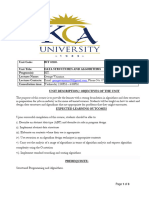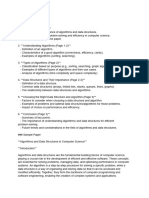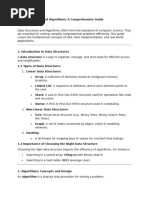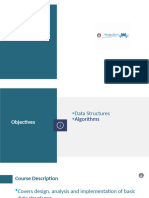0 ratings0% found this document useful (0 votes)
45 viewsIntroduction To Data Structures and Algorithms
This document provides an overview of topics to cover in an introduction to data structures and algorithms including common data structures like arrays and linked lists, analyzing algorithms using Big O notation, sorting and searching algorithms, and dynamic programming and greedy algorithms. It suggests tailoring the presentations to the audience's experience level and including code examples and applications to make the content more engaging.
Uploaded by
writesharoonCopyright
© © All Rights Reserved
Available Formats
Download as DOCX, PDF, TXT or read online on Scribd
0 ratings0% found this document useful (0 votes)
45 viewsIntroduction To Data Structures and Algorithms
This document provides an overview of topics to cover in an introduction to data structures and algorithms including common data structures like arrays and linked lists, analyzing algorithms using Big O notation, sorting and searching algorithms, and dynamic programming and greedy algorithms. It suggests tailoring the presentations to the audience's experience level and including code examples and applications to make the content more engaging.
Uploaded by
writesharoonCopyright
© © All Rights Reserved
Available Formats
Download as DOCX, PDF, TXT or read online on Scribd
You are on page 1/ 1
1.
Introduction to Data Structures and Algorithms:
This presentation serves as a basic overview of what data structures and
algorithms are, why they are important in computer science, and how they relate
to problem-solving.
2. Common Data Structures in DSA:
Explore various data structures like arrays, linked lists, stacks, queues, trees, and
graphs. Discuss the characteristics, use cases, and time complexity of these
structures.
3. Algorithm Analysis and Big O Notation:
Explain the concept of algorithm analysis, focusing on time and space complexity.
Introduce Big O notation and show how it is used to assess the efficiency of
algorithms.
4. Sorting and Searching Algorithms:
Present the most common sorting and searching algorithms, including bubble
sort, quicksort, binary search, and more. Discuss their advantages, disadvantages,
and when to use each.
5. Dynamic Programming and Greedy Algorithms:
Explain the principles of dynamic programming and greedy algorithms. Provide
examples of problems that can be solved using these techniques and compare
their strengths and weaknesses.
Each of these presentations can be tailored to your audience's level of familiarity with
DSA, whether they are beginners or more experienced individuals. Additionally, you can
include code examples and practical applications to make the content more engaging
and educational.
You might also like
- 1.BIT 02105 DATA STRUCTURES AND ALGORITHMS Course OutlineNo ratings yet1.BIT 02105 DATA STRUCTURES AND ALGORITHMS Course Outline3 pages
- Overview in Data Structure Guided QuestionsNo ratings yetOverview in Data Structure Guided Questions3 pages
- CNS - Data Structures & Algorithms - IntroductionNo ratings yetCNS - Data Structures & Algorithms - Introduction25 pages
- Data Structures and Algorithms Suggestions byNo ratings yetData Structures and Algorithms Suggestions by3 pages
- PROJECT REPORT ApnaRooms Manoranjan 12219036No ratings yetPROJECT REPORT ApnaRooms Manoranjan 1221903624 pages
- Data Structure and Algorithms IntroductionNo ratings yetData Structure and Algorithms Introduction2 pages
- Course Syllabus Data Structures and AlgorithmNo ratings yetCourse Syllabus Data Structures and Algorithm11 pages
- Data Structures & Algorithms _ Faisal's Notes (1)No ratings yetData Structures & Algorithms _ Faisal's Notes (1)3 pages
- BIS123 - Data Structures and Algorithms Course OutlineNo ratings yetBIS123 - Data Structures and Algorithms Course Outline2 pages
- BITS F232 FOUNDATIONS OF DATA STRUCTURES AND ALGORITHMS_HANDOUTNo ratings yetBITS F232 FOUNDATIONS OF DATA STRUCTURES AND ALGORITHMS_HANDOUT5 pages
- 2.0 Introduction To Data Structures and AlgorithmsNo ratings yet2.0 Introduction To Data Structures and Algorithms31 pages
- Data Structures and Algorithms AssignmentNo ratings yetData Structures and Algorithms Assignment62 pages



























































